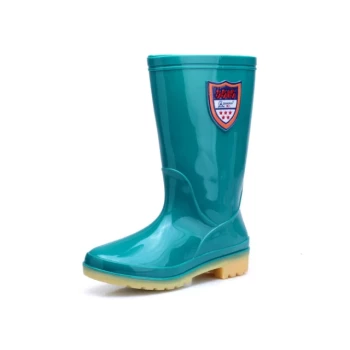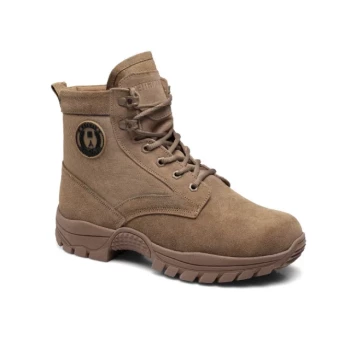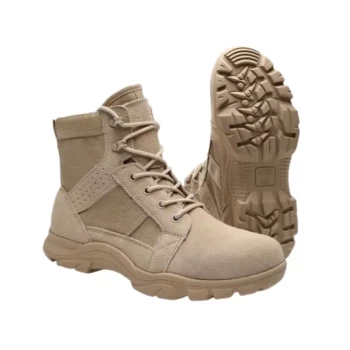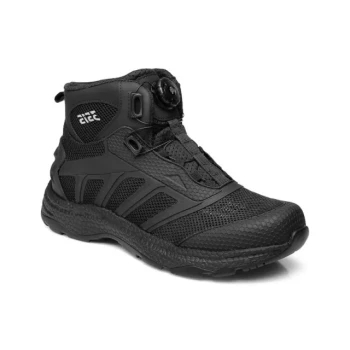To put it simply, thicker leather is crucial for winter boots because it provides a more substantial physical barrier against the cold and is more durable in harsh conditions. While a standard work boot might use 3-4 ounce leather, a true winter boot needs at least 8-ounce leather to effectively slow the seepage of cold and stand up to snow, ice, and salt.
While leather thickness is a primary factor for insulation and durability, it is only one component of a complete winter boot system. True winter performance depends on how that thick leather works in concert with waterproofing, internal lining, and sole construction.
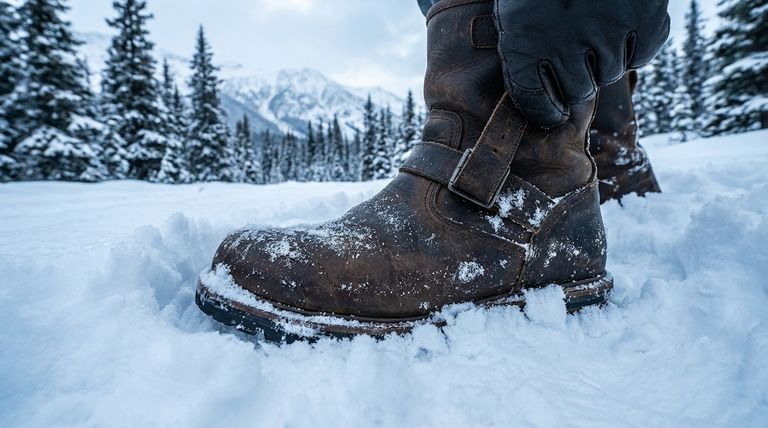
The Role of Thickness in Winter Performance
The choice of thick leather for winter boots is a deliberate engineering decision designed to combat the fundamental challenges of a cold environment. It serves multiple protective functions beyond what is required in milder weather.
A Barrier Against Cold Seepage
Thicker leather has greater density. This density acts as a natural insulator, slowing down the rate at which the cold outside can penetrate the boot and reach your foot. This creates a more stable, warmer internal environment.
Enhanced Durability for Harsh Conditions
Winter introduces unique stressors like ice, abrasive snow, and corrosive salt or de-icing chemicals. Thicker leather offers superior resistance to cracking, abrasion, and general deterioration from these extreme elements, directly impacting the boot's lifespan.
Structural Support in Deep Snow
Winter boots often feature a higher upper to prevent snow from getting inside. A thicker, more rigid leather provides the necessary ankle support and stability needed for trudging through deep snow or navigating uneven, icy terrain.
Why Thickness Isn't the Only Factor
Focusing solely on leather thickness gives you an incomplete picture. A truly effective winter boot is an integrated system where each part complements the others to keep your feet warm, dry, and secure.
The Critical Need for Waterproofing
Leather is naturally porous. Even the thickest hide will eventually become saturated with water, which rapidly pulls heat away from your feet. A waterproof membrane, like Gore-Tex, or a thorough waterproofing treatment is the first line of defense against melting snow and slush.
The Power of Thermal Insulation
While thick leather helps, the primary source of warmth in a winter boot comes from its internal lining. Materials specifically designed for thermal insulation trap air and hold in your body's heat far more efficiently than leather alone.
Sole Design for Grip and Ground-Chill
The sole of the boot is your direct contact with the frozen ground. A thick rubber sole with deep treads serves two purposes: it provides essential grip to prevent slips and it creates critical distance between your foot and the cold ground, reducing heat loss through conduction.
Understanding the Trade-offs
Opting for the thickest possible leather isn't always the best solution. It's important to recognize the potential downsides to make an informed choice.
Weight and Flexibility
The most obvious trade-off is weight. Thicker leather is significantly heavier and stiffer, which can lead to fatigue over long distances and often requires a longer, more difficult break-in period.
Reduced Breathability
Extremely thick or heavily treated leather can limit the boot's ability to breathe. This can trap sweat, leading to damp feet, which ironically makes them feel colder and can cause blisters.
Maintenance is Non-Negotiable
All leather requires care, but the stakes are higher in winter. Without proper cleaning and conditioning, salt can permanently damage the leather, and repeated wet-dry cycles can cause even the thickest hide to crack.
Making the Right Choice for Your Goal
Select a boot by matching its construction to your most common winter activity.
- If your primary focus is extreme cold and deep snow: Prioritize maximum leather thickness (8oz+) combined with a waterproof membrane and heavy thermal insulation.
- If your primary focus is navigating wet, slushy urban winters: A moderate thickness leather with excellent waterproofing and a quality insulated lining offers a better balance of protection and comfort.
- If your primary focus is active winter use like hiking: Look for a balance of moderate leather thickness for support with a lighter overall weight and superior breathability.
Ultimately, understanding how leather thickness functions as part of the entire boot system empowers you to choose footwear that truly meets the demands of your winter.
Summary Table:
| Key Factor | Why It Matters for Winter Boots |
|---|---|
| Leather Thickness | Slows cold seepage, provides durability against ice and salt, and offers structural support. |
| Waterproofing | Essential to prevent leather from becoming saturated, which rapidly draws heat away from feet. |
| Thermal Insulation | The primary source of warmth, trapping body heat far more effectively than leather alone. |
| Sole Construction | Provides grip on ice and creates a barrier against ground-chill to reduce heat loss. |
Need a reliable partner for your winter boot line?
As a large-scale manufacturer, 3515 produces a comprehensive range of footwear for distributors, brand owners, and bulk clients. Our production capabilities encompass all types of durable, high-performance shoes and boots. We can help you develop the perfect winter boot, integrating the right leather thickness with advanced waterproofing and insulation technologies to meet your customers' demands.
Contact our expert team today to discuss your production needs and get a quote.
Visual Guide

Related Products
- Safety Footwear Wholesale Manufacturer for Custom OEM/ODM Production
- Wholesale Safety Footwear Manufacturer for Bulk & Custom OEM Orders
- Premium Wholesale Waterproof Safety Boots High Performance Protection for Industrial Markets
- Factory-Direct Wholesale Canvas Boots with High-Traction Rubber Soles
- Customizable Anti-Smash Safety Boots for Wholesale & Private Label Manufacturing
People Also Ask
- What do heavy duty boots do? Protect Your Feet in Demanding Work Environments
- Is it normal to wear shoes in the house? A Guide to Hygiene, Comfort & Culture
- What are the differences between steel toe, composite toe, and alloy toe Wellington boots? Choose the Right Safety Toe for Your Job
- Do snake bite boots work? Your Ultimate Guide to Effective Snake Bite Protection
- How long can you wear safety boots? The Lifespan is Determined by Wear, Not Time








